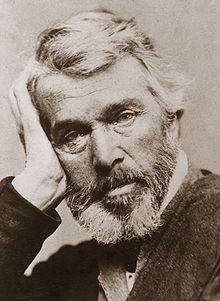
We have no idea what Spey Street is like now for local residents at night. But roughly 200 years ago it was a source of huge frustration for one of the 19th century’s most influential and ill-tempered literary figures.
Thomas Carlyle (1795–1881) – essayist, philosopher, historian and sociologist – lived here in lodgings at No. 2 from 1822–24, although at that time it was known as Moray Street.

Herbert Spencer (in An Autobiography, 1904) remarked of Carlyle from personal experience:
Naturally, with his constitutional tendency to antagnism, his delight in strong words, and his unmeasured assumption of superiority, he was ever finding occasion to scorn and condemn and denounce. By use, a morbid desire had been fostered in him to find badness everwhere, unqualified by any goodness. He had a daily secretion of curses which he had to vent on somebody or something.
In Spey Street, it was a lap dog, which he described in a letter to his mother of 2 June 1822 as ‘an ugly messan which a half-crazy half-pay captain thought proper to chain in his garden’ some 20 yards from Carlyle’s chamber.
Perhaps it was writing the Life of Schiller which tipped the great man over the edge, or the fact that he was also working as a teacher, or perhaps just the unrelenting bloody yapping. In the same letter he described what happened next:
I listened about half an hour, then rose indignantly, put on my clothes, went out, and charged the watchman to put a stop to the accursed thing. The watchman would not for the world interfere with a gentleman’s rest at that hour, but next morning he would certainly, etc. I asked to be shown the door, and pulling the crazy captain’s bell about six times, his servant at length awoke, and inquired in a tremulous voice, What was it? I alluded to the dog and demanded the instant, the total, the everlasting removal ot it, or to-morrow I would see whether justice was in Edinburgh or the shadow of British law in force. ‘Do you hear that?’ said the Irish knight of the rattle and the lanthorn [I think, the watchman]. She heard it and obeyed, and no wretched messan has since disturbed my slumbers.
The anecdote was later included in James Froude’s controversial Life of Carlyle in 1884, and a drawing of the property appears in Wilmot Harrison’s Memorable Edinburgh Houses, revised and enlarged by Oliphant Smeaton in 1898 (see below).
Walt Whitman, in ‘Death of Carlyle’ (The Critic, 12 February 1881) observed:
As a representative author, a literary figure, no man else will bequeathe to the future more significant hints of our stormy era, its fierce paradoxes, its din, and its struggling parturition periods, than Carlyle, He belongs to his own branch of the stock too; neither Latin nor Greek, but altogether Gothic. Rugged, mountainous, volcanic, he was himself more a French Revolution than any of his volumes.

----------------------
.@theSpurtle I dont live in Spey St. But recently there has been a yap yap bloody yap dog yapping in my tenement. Its driving me nuts.
 New Town Flâneur @NewTownFlaneur
New Town Flâneur @NewTownFlaneur
@theSpurtle He should have emailed CEC's Noise Team. They're usually quite helpful.
From Alison Campbell: Here’s Mrs Carlyle in similar mode –
@NewTownFlaneur @theSpurtle Carlyle should have stayed on the Comely Bank Road. No yapping dogs allowed to break its genteel quiet.

